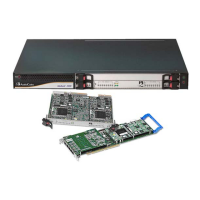Version 5.2 367 September 2007
SIP User's Manual 8. Networking Capabilities
To resolve these issues, the following mechanisms are available:
STUN (refer to 'STUN' on page 367)
First Incoming Packet Mechanism (refer to 'First Incoming Packet Mechanism' on
page 368)
RTP No-Op packets according to the avt-rtp-noop draft (refer to 'No-Op Packets' on
page 368)
For information on SNMP NAT traversal, refer to the SIP Series Reference Manual.
8.3.1 STUN
Simple Traversal of UDP through NATs (STUN), based on RFC 3489 is a client / server
protocol that solves most of the NAT traversal problems. The STUN server operates in the
public Internet and the STUN clients are embedded in end-devices (located behind NAT).
STUN is used both for the signaling and the media streams. STUN works with many
existing NAT types and does not require any special behavior.
STUN enables the gateway to discover the presence (and types) of NATs and firewalls
located between it and the public Internet. It provides the gateway with the capability to
determine the public IP address and port allocated to it by the NAT. This information is later
embedded in outgoing SIP / SDP messages and enables remote SIP user agents to reach
the gateway. It also discovers the binding lifetime of the NAT (the refresh rate necessary to
keep NAT ‘Pinholes’ open).
On startup, the gateway sends a STUN Binding Request. The information received in the
STUN Binding Response (IP address:port) is used for SIP signaling. This information is
updated every user-defined period (NATBindingDefaultTimeout).
At the beginning of each call and if STUN is required (i.e., not an internal NAT call), the
media ports of the call are mapped. The call is delayed until the STUN Binding Response
(that includes a global IP:port) for each media (RTP, RTCP and T.38) is received.
To enable STUN, perform the following:
Enable the STUN feature using either the Embedded Web Server (refer to
'Configuring the Application Settings' on page 157) or the ini file (set EnableSTUN to
1).
Define the STUN server address using one of the following methods:
• Define the IP address of the primary and the secondary (optional) STUN servers
using either the Embedded Web Server (refer to 'Configuring the Application
Settings' on page 157) or the ini file (STUNServerPrimaryIP and
STUNServerSecondaryIP). If the primary STUN server isn’t available, the
gateway attempts to communicate with the secondary server.
• Define the domain name of the STUN server using the ini file parameter
StunServerDomainName. The STUN client retrieves all STUN servers with an
SRV query to resolve this domain name to an IP address and port, sort the server
list, and use the servers according to the sorted list.
Use the ini file parameter NATBindingDefaultTimeout to define the default NAT
binding lifetime in seconds. STUN is used to refresh the binding information after this
time expires.

